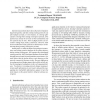Free Online Productivity Tools
i2Speak
i2Symbol
i2OCR
iTex2Img
iWeb2Print
iWeb2Shot
i2Type
iPdf2Split
iPdf2Merge
i2Bopomofo
i2Arabic
i2Style
i2Image
i2PDF
iLatex2Rtf
Sci2ools
DSN
2003
IEEE
2003
IEEE
A Study of Packet Delivery Performance during Routing Convergence
Internet measurements have shown that network failures happen frequently, and that existing routing protocols can take multiple seconds, or even minutes, to converge after a failure. During these routing convergence periods, some packets may already be en-route to their destinations and new packets may be sent. These in-flight packets can encounter routing loops, delays, and losses. However, little is known about how many packets are delivered (or not delivered) during routing convergence periods. In this paper, we study the impact of topological connectivity and routing protocol designs on the packet delivery during routing convergence. We examine three distributed routing protocols: RIP, Distributed Bellman Ford and BGP through protocol analysis and simulation experiments. Our study shows that the packet delivery ratio improves as the network connectivity becomes richer. However differences in routing protocol designs impact their ability to fully utilize the topological redundancy...
| Added | 04 Jul 2010 |
| Updated | 04 Jul 2010 |
| Type | Conference |
| Year | 2003 |
| Where | DSN |
| Authors | Dan Pei, Lan Wang, Daniel Massey, Shyhtsun Felix Wu, Lixia Zhang |
Comments (0)

